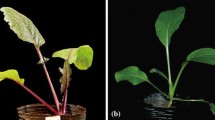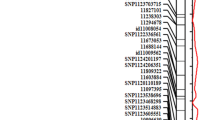Abstract
Anthocyanins and proanthocyanidins are the primary pigments of red rice and are also important functional nutrients for human health. To identify novel quantitative trait loci (QTLs) underlying anthocyanins and proanthocyanidins (ANC and PAC) in rice, a recombinant inbred line (RIL) derived from a cross of red rice ‘Hong Xiang 1’ (‘HX1’) and white rice ‘Song 98-131’ (‘S98-131’) was cultivated in six environments. A genetic map containing 126 markers covering 1833.4 cM with an average of 14.55 cM between markers was constructed. A total of 21 additive QTLs (A-QTLs) for ANC and PAC were identified from six environments using the IciMapping v3.3 software. Two new QTLs, qANC3 and qPAC12-4, were detected in several environments, and explained significant phenotypic variance. Nine QTLs of ANC and PAC were detected with additive × environmental interaction effects (AE effects) by QTLNetwork 2.1 software, but no epistatic and epistatic × environmental interaction effects (AA and AAE effects) were detected. The information obtained in this study could be useful for fine mapping and molecular marker-assisted selection of ANC and PAC in rice.



Similar content being viewed by others
Change history
14 December 2017
The author H.L. Chang is affiliated with “Innovation Center, Suihua Branch of Heilongjiang Academy of Agricultural Sciences, Suihua 152052, People’s Republic of China” in addition to the institution listed in the original publication.
References
Acquaviva R, Russo A, Galvano F, Galvano G, Barcellona ML, Volti GL, Vanella A (2003) Cyanidin and cyanidin 3-O-β-D-glucoside as DNA cleavage protectors and antioxidants. Cell Biol Toxicol 19(4):243–252
Agarwal C, Sharma Y, Zhao JF, Agarwal R (2000) A polyphenolic fraction from grape seeds causes irreversible growth inhibition of breast carcinoma MDA-MB468 cells by inhibiting mitogen-activated protein kinases activation and inducing G1 arrest and differentiation. Clin Cancer Res 6(7):2921–2930
Bagchi D, Krohn RL, Balmoori J, Bagchi M, Garg A, Stohs SJ (1999) Comparative in vitro and in vivo free radical scavenging abilities of a novel grape seed proanthocyanidin extract and selected antioxidants. Nat Antioxid Anticarcinog Nutr Health Dis 240:178–187
Barchi L, Lanteri S, Portis E, Valè G, Volante A, Pulcini L, Ciriaci T, Acciarri N, Barbierato V, Toppino L, Rotino GL (2012) A rad tag derived marker based eggplant linkage map and the location of QTLs determining anthocyanin pigmentation. PLoS ONE 7(8):e43740
Bonneau J, Taylor J, Parent B, Bennett D, Reynolds M, Feuillet C, Langride P, Mather D (2013) Multi-environment analysis and improved mapping of a yield-related QTL on chromosome 3B of wheat. Theore Appl Genet 126(3):747–761
Cao G, Zhu J, He C, Gao Y, Wu P (2001) impact of epistasis and QTL × environment interaction on the developmental behavior of plant height in rice (Oryza sativa L.). Theor Appl Genet 103(1):153–160
Cavagnaro PF, Iorizzo M, Yildiz M, Senalik D, Parsons J, Ellison S, Simon PW (2014) A gene-derived SNP-based high resolution linkage map of carrot including the location of QTL conditioning root and leaf anthocyanin pigmentation. BMC genom 15(1):1118
Chaim AB, Borovsky Y, Jong WD, Paran I (2003) Linkage of the A locus for the presence of anthocyanin and fs10.1, a major fruit-shape QTL in pepper. Theor Appl Genet 106(5):889–894
Cheng XD, Yan XJ, Hu MZ (2016) The effect of storage pressure on the mechanical properties of paddy grains. J Stored Prod Res 68:19–24
Dong YJ, Xu JL, Xiao K, Zhang YJ, Zhang JZ, Luo LJ, Mastuo M (2008) Genomic regions associated with the degree of red coloration in pericarp of rice (Oryza sativa L.). J Cereal Sci 48(2):556–560
Doyle J (1990) Isolation of plant dna from fresh tissue. Focus 12:13–15
Finocchiaro F, Ferrari B, Gianinetti A, Dall’Asta C, Galaverna G, Scazzina F, Pellegrini N (2007) Characterization of antioxidant compounds of red and white rice and changes in total antioxidant capacity during processing. Mol Nutr Food Res 51(8):1006–1019
Finocchiaro F, Ferrari B, Gianinetti A (2010) A study of biodiversity of flavonoid content in the rice caryopsis evidencing simultaneous accumulation of anthocyanins and proanthocyanidins in a black-grained genotype. J Cereal Sci 51(1):28–34
Furukawa T, Maekawa M, Oki T, Suda I, Iida S, Shimada H, Takamure I, Kadowaki K (2006) The Rc and Rd genes are involved in proanthocyanidin synthesis in rice pericarp. Plant J Cell Mol Biol 49(1):91–102
Ghosh M, Patra PK, Bhattacharyya C (2014) Effect of limited irrigation on growth and yield of rice varieties in a typic haplustalf soil of red and laterite zone of west bengal. J Crop Weed 10(634):42–47
Grassi D, Necozione S, Lippi C, Croce G, Valeri L, Pasqualetti P, Desideri G, Blumberg JB, Ferri C (2005) Cocoa reduces blood pressure and insulin resistance and improves endothelium-dependent vasodilation in hypertensives. Hypertension 46(2):398–405
Ha BK, Kim HK, Kang ST (2012) Mapping QTLs with epistatic effects and QTL-by-environment interactions for seed coat cracking in soybeans. Euphytica 186(3):933–942
Han L, Dong BC, Yang XJ, Huang CB, Wang XD, Wu XJ (2009) Study on flavonoids in the caryopsis of indica Rice Rdh. J Integr Agric 8(2):249–256
Hayashi K, Matsumoto S, Tsukazaki H, Kondo T, Kubo N, Hirai M (2010) Mapping of a novel locus regulating anthocyanin pigmentation in brassica rapa. Breed Sci 60(1):76–80
Heiss C, Kleinbongard P, Dejam A, Perré S, Schroeter H, Sies H, Kelm M (2005) Acute consumption of flavanol-rich cocoa and the reversal of endothelial dysfunction in smokers. J Am Coll Cardiol 46(7):1276–1283
Heiss C, Finis D, Kleinbongard P, Hoffmann A, Rassaf T, Kelm M, Sies H (2007) Sustained increase in flow-mediated dilation after daily intake of high-flavanol cocoa drink over 1 week. J Cardiovasc Pharmacol 49(2):74–80
Hosseini M, Houshmand S, Mohamadi S, Mohamadi S, Tarang A, Khodambashi M, Rahimsoroush H (2012) Detection of QTLs with main, epistatic and QTL × environment interaction effects for rice grain appearance quality traits using two populations of backcross inbred lines (BILs). Field Crops Res 135:97–106
Huang YF, Doligez A, Fournier-Level A, Cunff LL, Bertrand Y, Canaguier A, Morel C, Miralles V, Veran F, Souquet JM, Cheynier V, Terrier N, This P (2012) Dissecting genetic architecture of grape proanthocyanidin composition through quantitative trait locus mapping. BMC Plant Biol 12(1):30
Kim BG, Kim JH, Min SY, Shin KH, Kim JH, Kim HY, Ryu SN, Ahn JH (2007) Anthocyanin content in rice is related to expression levels of anthocyanin biosynthetic genes. J Plant Biol 50(2):156–160
Kim CK, Kikuchi S, Hahn JH, Park SC, Kim YH, Lee BW (2010) Computational identification of anthocyanin-specific transcription factors using a rice microarray and maximum boundary range algorithm. Evolut Bioinform 6(6):13
Kim CK, Cho MA, Choi YH, Kim JA, Kim YH, Kim YK, Park SH (2011) Identification and characterization of seed-specific transcription factors regulating anthocyanin biosynthesis in black rice. J appl genet 52(2):161–169
Koide T, Kamei H, Hashimoto Y, Kojima T, Hasegawa M (1996) Antitumor effect of hydrolyzed anthocyanin from grape rinds and red rice. Cancer Biother Radiopharm 11(4):273
Koponen JM, Happonen AM, Mattila PH, Törrönen AR (2007) Contents of anthocyanins and ellagitannins in selected foods consumed in Finland. J Agricu Food Chem 55(4):1612–1619
Lark KG, Chase K, Adler F, Mansur LM, Orf JH (1995) Interactions between quantitative trait loci in soybean in which trait variation at one locus is conditional upon a specific allele at another. Proc Natl Acad Sci USA 92(10):4656–4660
Lazze MC, Pizzala R, Savio M, Stivala LA, Prosperi E, Bianchi L (2003) Anthocyanins protect against DNA damage induced by tert-butyl-hydroperoxide in rat smooth muscle and hepatoma cells. Mutat Res 535(1):103–115
Li H, Ye G, Wang J (2007) A modified algorithm for the improvement of composite interval mapping. Genetics 175(1):361–374
Liu C, Ding NF, Fu QL, Brookes PC, Xu J, Guo B, Lin YC, Li H, Li NY (2016) The influence of soil properties on the size and structure of bacterial and fungal communities along a paddy soil chronosequence. Eur J Soil Biol 76:9–18
McCouch SR, Cho YG, Yano M, Paul E, Blinstrub M, Morishima H, Kinoshita T (1997) Report on QTL nomenclature. Rice Genet Newsl 14:11–14
Messmer R, Fracheboud Y, Bänziger M, Vargas M, Stamp P, Ribaut JM (2009) Drought stress and tropical maize: qTL-by-environment interactions and stability of QTLs across environments for yield components and secondary traits. Theor Appl Genet 119(5):913–930
Miller MG, Shukitt-Hale B (2012) Berry fruit enhances beneficial signaling in the brain. J Agric Food Chem 60(23):5709
Molina J, Sikora M, Garud N, Flowers JM, Rubinstein S, Reynolds A, Huang P, Jackson S, Schaal BA, Bustamante CD, Boyko AR, Purugganan MD (2011) Molecular evidence for a single evolutionary origin of domesticated rice. Proc Natl Acad Sci USA 108(20):8351
Norberto S, Silva S, Meireles M, Faria A, Pintado M, Calhau C (2013) Blueberry anthocyanins in health promotion: a metabolic overview. J Funct Foods 5(4):1518–1528
Oki T, Masuda M, Kobayashi M, Nishiba Y, Furuta S, Suda I, Sato T (2002) Polymeric procyanidins as radical-scavenging components in red-hulled rice. J Agric Food Chem 50(26):7524–7529
Pang YZ, Wenger JP, Saathoff K, Peel GJ, Wen JQ, Huhman D, Allen SN, Tang Y, Cheng XF, Tadege M, Ratet P, Mysore KS, Sumner LW, Marks MD, Dixon RA (2009) A WD40 repeat protein from Medicago truncatula is necessary for tissue-specific anthocyanin and proanthocyanidin biosynthesis but not for trichome development. Plant Physiol 151(3):1114–1129
Przybylski R, Lee YC, Eskin NAM (1998) Antioxidant and redicl-scavenging activities of buckwheat seed components. J American Oil Chemists’ Society 75(11):1595–1601
Russo A, Fauci LL, Acquavivi R, Campisi A, Raciti G, Scifo C, Renis M, Galvano G, Vanella A, Galvano F (2005) Ochratoxin A-induced DNA damage in human fibroblast: protective effect of cyanidin 3-O-β-D-glucoside. J Nutr Biochem 16(1):31–37
Shi B, Du X (2006) The progress on research and utilization of plant proanthocyanidins. J Sichuan Univ 38(5):16–24
Sweeney MT, Thomson MJ, Pfeil BE, Mccouch S (2006) Caught red-handed: Rc encodes a basic Helix-Loop-Helix protein conditioning red pricarp in rice. Plant Cell 18(2):283–294
Taubert D, Roesen R, Lehmann C, Jung N, Schömig E (2007) Effects of low habitual cocoa intake on blood pressure and bioactive nitric oxide: a randomized controlled trial. JAMA, J Am Med Assoc 298(1):49–60
Trigiano RN, Caetano-Anolles G (1998) Laboratory exercises on DNA amplification fingerprinting for evaluating the molecular diversity of horticultural species. Horttechnology 8(3):413–422
Tsuda T (2012) Dietary anthocyanin-rich plants: biochemical basis and recent progress in health benefits studies. Mol Nutr Food Res 56(1):159–170
Williamson G, Clifford MN (2010) Colonic metabolites of berry polyphenols: the missing link to biological activity? Br J Nutr 104(S3):S48–S66
Winkel-shirley B (2001) Flavonoid biosynthesis. a colorful model for genetics, biochemistry, cell biology, and biotechnology. Plant Physiol 126(2):485–493
Yang J, Zhu J, Williams RW (2007) Mapping the genetic architecture of complex traits in experimental populations. Bioinformatics 23(12):1527–1536
Yu SB, Li JX, Tan YF, Gao YJ, Li XH, Zhang QF, Maroof MAS (1997) Importance of epistasis as the genetic basis of heterosis in an elite rice hybrid. Proc Natl Acad Sci USA 94(17):9226–9231
Yuan YW, Sagawa JM, Young RC, Christensen BJ, Bradshaw HD Jr (2013) Genetic dissection of a major anthocyanin qtl contributing to pollinator-mediated reproductive isolation between sister species of mimulus. Genetics 194(1):255–263
Acknowledgements
This work was supported by the major science and technology fund bidding project in Heilongjiang province (GA14B102-02).
Author information
Authors and Affiliations
Corresponding author
Additional information
T. Y. Xu, J. Sun and H. L. Chang have contributed equally to this work.
A correction to this article is available online at https://doi.org/10.1007/s10681-017-2084-0.
Rights and permissions
About this article
Cite this article
Xu, T.Y., Sun, J., Chang, H.L. et al. QTL mapping for anthocyanin and proanthocyanidin content in red rice. Euphytica 213, 243 (2017). https://doi.org/10.1007/s10681-017-2035-9
Received:
Accepted:
Published:
DOI: https://doi.org/10.1007/s10681-017-2035-9




